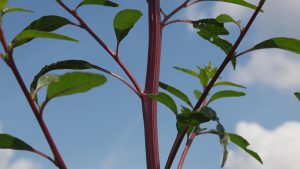Growing resistance

HERBICIDE RESISTANCE IS defined by the Weed Science Society of America as ‘the inherited ability of a plant to survive and reproduce following exposure to a dose of herbicide that was previously lethal’. Herbicide resistance is a product of genetic diversity and selection pressure. Every generation, plants (and all things with DNA) are subjected to random genetic mutations, most of these mutations are obsolete and cause no impact, however, some of them provide advantageous traits, such as resistance to a herbicide. When a herbicide is applied to a population, the susceptible individuals are controlled, leaving only the resistant biotypes that return seed to the seedbank.
WATERHEMP
Waterhemp is a summer-annual weed closely related to redroot and green pigweed, and the most recently confirmed case of herbicide resistance in Ontario. Waterhemp is distinguishable by its completely hairless stem and narrow, waxy, hairless leaves. At flowering, waterhemp inflorescence is more delicate and branched than either redroot or green pigweed.
Waterhemp populations have been present on Ontario’s west coast since the late 1800s, but the weed was largely confined to non-crop areas adjacent to open watercourses. In 2002, the first waterhemp population with resistance to herbicide Group 2 and Group 5 was confirmed in Lambton County. Populations resistant to glyphosate were confirmed in 2014, and resistance to Group 14 herbicides was confirmed in 2018. Waterhemp is the first weed in Ontario with confirmed resistance to Group 14 herbicides and the first weed with resistance to four herbicide modes of action.
Waterhemp has been confirmed in seven Ontario counties (Essex, Chatham-Kent, Lambton, Middlesex, Huron, Haldimand, and Wentworth), as well as in the province of Quebec. Waterhemp seed collected from Chatham-Kent, Huron, Middlesex, Haldimand, and Wentworth in 2018, are currently being screened for resistance.



THREAT
Apart from resistance to four herbicide modes of action (which is enough of a point on its own to consider it a threat), waterhemp is both highly competitive and highly productive. Waterhemp is dioecious, housing male and female reproductive organs on separate plants. Because of this, two plants are required for successful seed production increasing genetic diversity. Obligatory cross-breeding means that there is an increased likelihood of developing a genetic mutation that codes for herbicide resistance and that the gene will rapidly spread within, and across, populations. In addition to an increased likelihood of developing resistance, female waterhemp plants are highly productive. A single female plant is capable of producing over four million seeds under optimal conditions; when in competition with a crop, a single female plant will produce up to 300,000 seeds. Seeds will remain viable in the soil for three to five years. They can be dispersed on contaminated farm equipment, in contaminated seed, in the gut of water fowl, via waterways, or human traffic.
GROUP 14 RESISTANCE
The Group 14 gene mutation confers resistance to all POST-applied Group 14 herbicides (Blazer, Reflex, BlackHawk, and Eragon). Soil applications of Group 14 herbicides (Authority, Valtera) still provide residual control of waterhemp that has not emerged at the time of application, but do not provide control of weeds emerged at the time of application. After the application of a Group 14 herbicide, resistant plants will show severe injury for one to three weeks and then regrowth begins from auxiliary buds. The injured plants are able to produce viable seed that will have to be controlled in subsequent years.
PREVENTION
- There are steps farmers can take on-farm to prevent multiple-resistant waterhemp.
- Scout your fields and know what to look for! Proper identification is the first step to combatting waterhemp.
- Tankmix multiple effective modes of action and rotate herbicide groups. Tank-mixing improves control and reduces the selection pressure for resistant weeds.
- Scout your fields again; take special note of any escapes. If you applied a Group 14 herbicide, scout three to five weeks after application.
- If you have a population of waterhemp in one of your fields, be as conscientious as you can when moving equipment from that field to the next one, be prepared to scout for waterhemp in that field the following year.
Hear more from Lauren Benoit in our GrainTALK podcast! Go to www.gfo.ca/podcasts and look for episode 18.
Lauren Benoit recently completed her MSc. studying the control and distribution of herbicide-resistant waterhemp in corn, under the supervision of Dr. Peter Sikkema at the University of Guelph. •




























